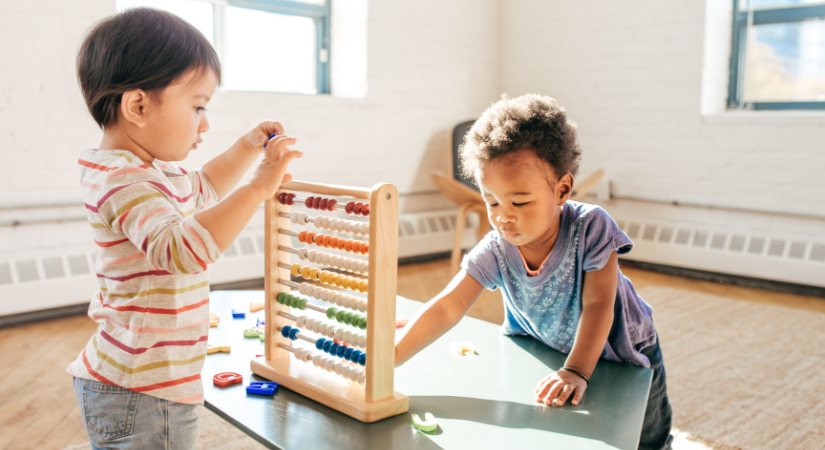STEM (Science, Technology, Engineering, and Mathematics) has become an increasingly popular topic within the education sector in the past few years, with a focus on getting more children involved in STEM activities. Introducing STEM activities aligned with the EYFS (Early Years Foundation Stage) framework not only helps foster their curiosity but also significantly enhances their development during their early years.
Whilst STEM is often perceived as a topic focused mainly on primary and secondary education, there are loads of ways you can use STEM activities for early years education. In this blog we explore 10 fun and educational early years STEM activities you can easily incorporate into your nursery setting.
Use the links below to jump into each activity:
- Exploring Magnets
- Building Structures with Blocks
- Water Play with Measuring Cups
- Nature Walks and Bug Hunts
- Planting Seeds
- Shadow Play
- Weather Charting
- Ice Excavation
- Bubble Science
- Shape Sorting
1. Exploring Magnets
What you’ll need:
- Magnets
- Magnetic materials
- Non-magnetic materials
Setup:
Put magnets, non-magnetic, and magnetic materials out on a low table. Encourage the children in your setting to use the magnets to test the materials and explore whether or not they stick to the magnet. Discuss with them about how they know if a material is magnetic or not.
You can take this hands-on EYFS STEM activity a step further and encourage the children to sort the items based on whether or not they’re attracted to the magnets.
This activity teaches basic principles of magnetism, distinguishing between magnetic and non-magnetic materials, and introduces scientific classification.
EYFS Links:
Understanding the World: Children explore and talk about different materials.
Communication and Language: Children discuss their findings and predictions.

2. Building Structures with Blocks
What you’ll need:
- Building blocks
Setup:
Set out a variety of different types of building blocks such as wooden, plastic, or foam ones. Encourage the children in your setting to build specific structures from the blocks like a tower or a bridge. For an added challenge you could ask the children to see if they can build a structure that holds an item such as a bridge that holds a toy car.
This engaging STEM activity introduces engineering concepts, spatial awareness, and structural integrity.
EYFS Links:
Physical Development: Improves motor skills through construction play.
Mathematics: Explores shapes, sizes, and patterns.
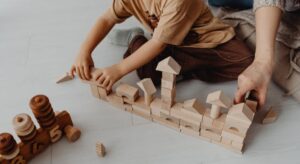
3. Water Play with Measuring Cups
What you’ll need:
- A water table or area
- Various containers, measuring cups, and funnels
- Objects that float
- Objects that sink
Setup:
Set up a water play area, this could either be a dedicated water table or a big tub filled with water. Provide the children with various objects to use to play with the water including measuring cups, containers, and funnels. You could also give the children different objects that sink or float to encourage them to discuss the way items act in the water.
This teaches principles of fluid dynamics, volume, and measurement.
EYFS Links:
Mathematics: Explores capacity, volume, and measurement.
Understanding the World: Investigates properties of water and objects.
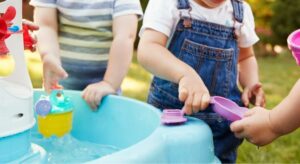
4. Nature Walks and Bug Hunts
What you’ll need:
- Magnifying glasses
- Bug jars
- Identification charts
- An outdoor space such as a garden or a park
Setup:
Organise a nature walk in a local outdoor space, this could be in your nursery garden or a local park. Encourage the children in your setting to explore the wildlife around them, including the plants, bugs, and other animals. Take it a step further and provide the children with magnifying glasses, bug jars, and identification charts to help them learn more about what they’re exploring.
This early years STEM activity introduces the concepts of biology, ecology, and environmental science through direct observation of living organisms.
EYFS Links:
Understanding the World: Observes living things and their environments.
Communication and Language: Children discuss findings and gain new vocabulary.
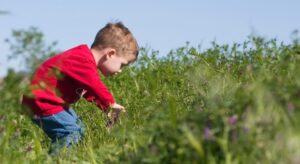
5. Planting Seeds
What you’ll need:
- Plant pots
- Soil
- Seeds
- Watering cans
Setup:
Set up a planting station in your setting with pots, seeds, soil, and watering cans. Help the children to plant the seeds in the pot and water them to start their growth. Encourage the children to place the plants in a sunny spot in your setting and water them regularly. Enjoy watching the plants grow as the children care for them!
This STEM activity teaches plant life cycles and responsibility in caring for living things.
EYFS Links:
Understanding the World: Explores plant life cycles and growth.
Personal, Social and Emotional Development: Develops care for living things.

6. Shadow Play
What you’ll need:
- A light source such as a lamp or a torch
- Various objects to create shadows
Setup:
Create a shadow exploration area with a blank surface such as a wall or a sheet and a source of light such as a lamp or torches. Place various objects in the area that the children can hold and move in front of the light to create and explore shadows and how they change when the objects move around.
This science-based STEM activity teaches the basic principles of light, shadows, and how light interacts with objects.
EYFS Links:
Understanding the World: Explores light and shadows.
Expressive Arts and Design: Encourages creativity in shadow play.

7. Weather Charting
What you’ll need:
- Paper
- Pencils/pens/crayons
- Images of the weather
Setup:
Create a weather chart in your setting with symbols for the different types of weather. Each day talk with the children about what the weather is like outside and encourage them to mark the weather on their weather chart. You could take it a step further and talk about what the children like or don’t like about the different weather conditions.
This STEM activity introduces meteorology and the interpretation of weather patterns in your children’s early learning.
EYFS Links:
Understanding the World: Observes and records weather conditions.
Communication and Language: Children discuss weather and associated vocabulary.

8. Ice Excavation
What you’ll need:
- Small toys
- Plastic tools
- Water and a freezer
Setup:
Create a frozen toy area by setting up a messy play table with toys frozen in ice. Provide lots of different tools for the children to explore the frozen toys and help them escape the ice! Talk to the children about which tools and techniques worked best for freeing the toys and what happened to the ice as it heated up in the room.
This chemistry-based STEM activity teaches about states of matter (solid, liquid), temperature effects, and observational skills.
EYFS Links:
Understanding the World: Exploring changes in materials (melting ice).
Physical Development: Fine motor skills through excavation.
Mathematics: Observing changes in size and shape as ice melts.

9. Bubble Science
What you’ll need:
- Bubble mixture
- Bubble wands
Setup:
Provide bubble solution and different types of bubble wands. Let children experiment with creating bubbles of different sizes. Encourage the children to try catching or touching the bubbles and discuss with them which bubble wands made the best bubbles and what happens when the bubbles touch different objects.
This EYFS STEM activity teaches about surface tension, air, and the properties of bubbles.
EYFS Links:
Physical Development: Coordination and motor skills.
Understanding the World: Observing bubble formation and properties.
Communication and Language: Discussing sizes and shapes of bubbles.
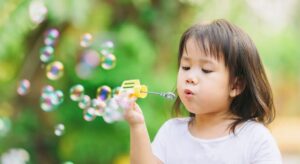
10. Shape Sorting
What you’ll need:
- Objects of different shapes
- Trays, bowls, or mats
Setup:
Create a shape sorting area by setting out sorting trays, bowls, or mats. Place a range of objects of all shapes and sizes around the sorting area and encourage the children to sort the objects by shape. Discuss with the children why they sorted out the objects the way they did and encourage them to think about the properties of the shapes.
This activity teaches geometry, categorisation, and early maths skills.
EYFS Links:
Mathematics: Recognizing and naming shapes.
Physical Development: Fine motor skills through sorting.
Communication and Language: Describing shapes and sorting criteria.
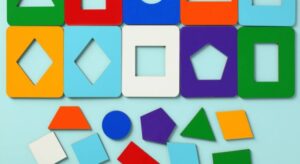
Incorporating these STEM activities for early years into your EYFS curriculum can significantly enhance children’s learning experiences. Not only will your children thrive and achieve developmental milestones, they will also foster an interest in science, technology, engineering, and mathematics from a young age.
Freeing up time so that you can plan and prepare creative and engaging activities within your nursery settings can be challenging. Solutions such as nursery management software can help streamline your administrative workload, allowing you to spend more time ensuring your nursery environment is both educational and fun. Contact the team at eyworks at hello@eyworks.co.uk to learn more or book in a demo today.
